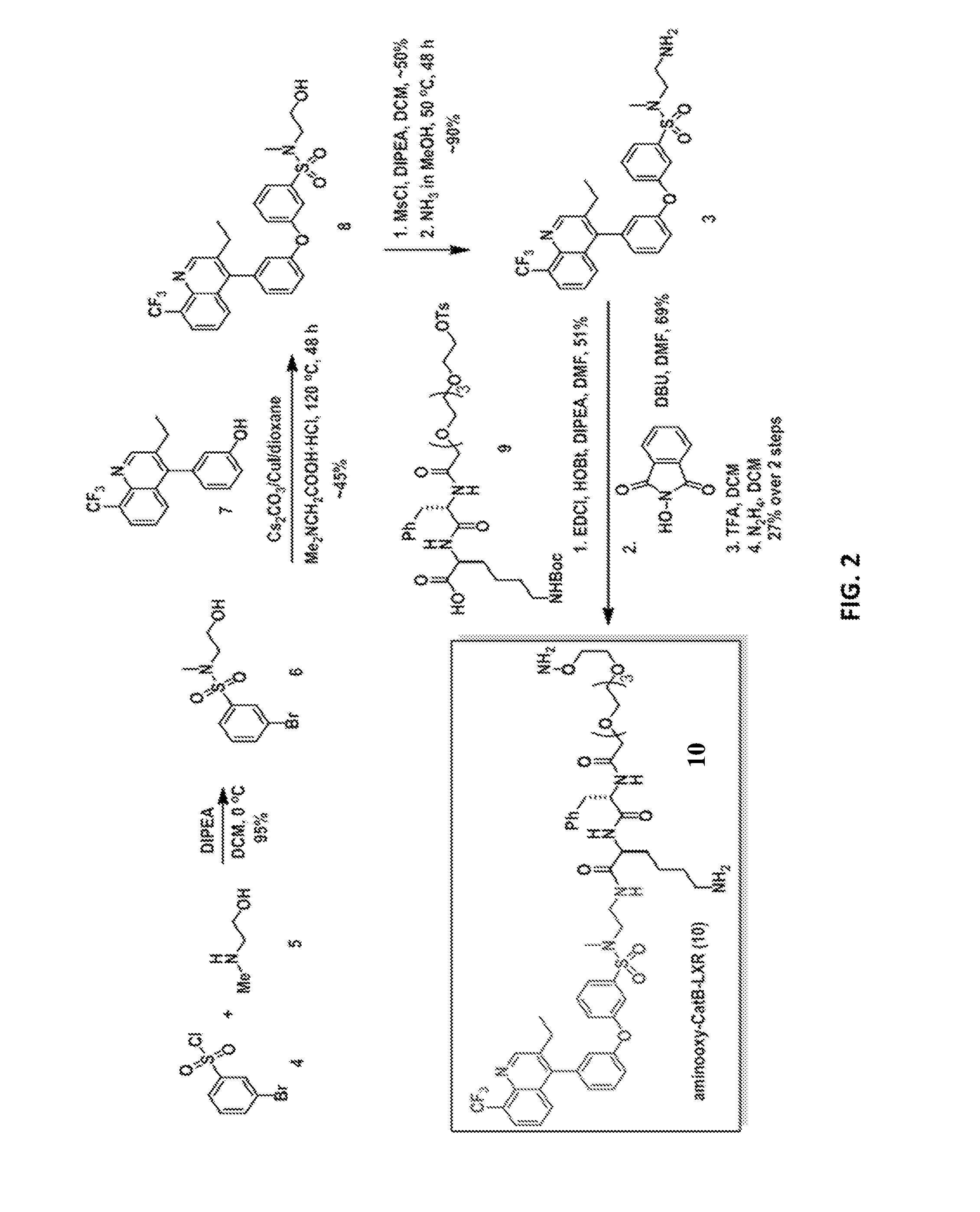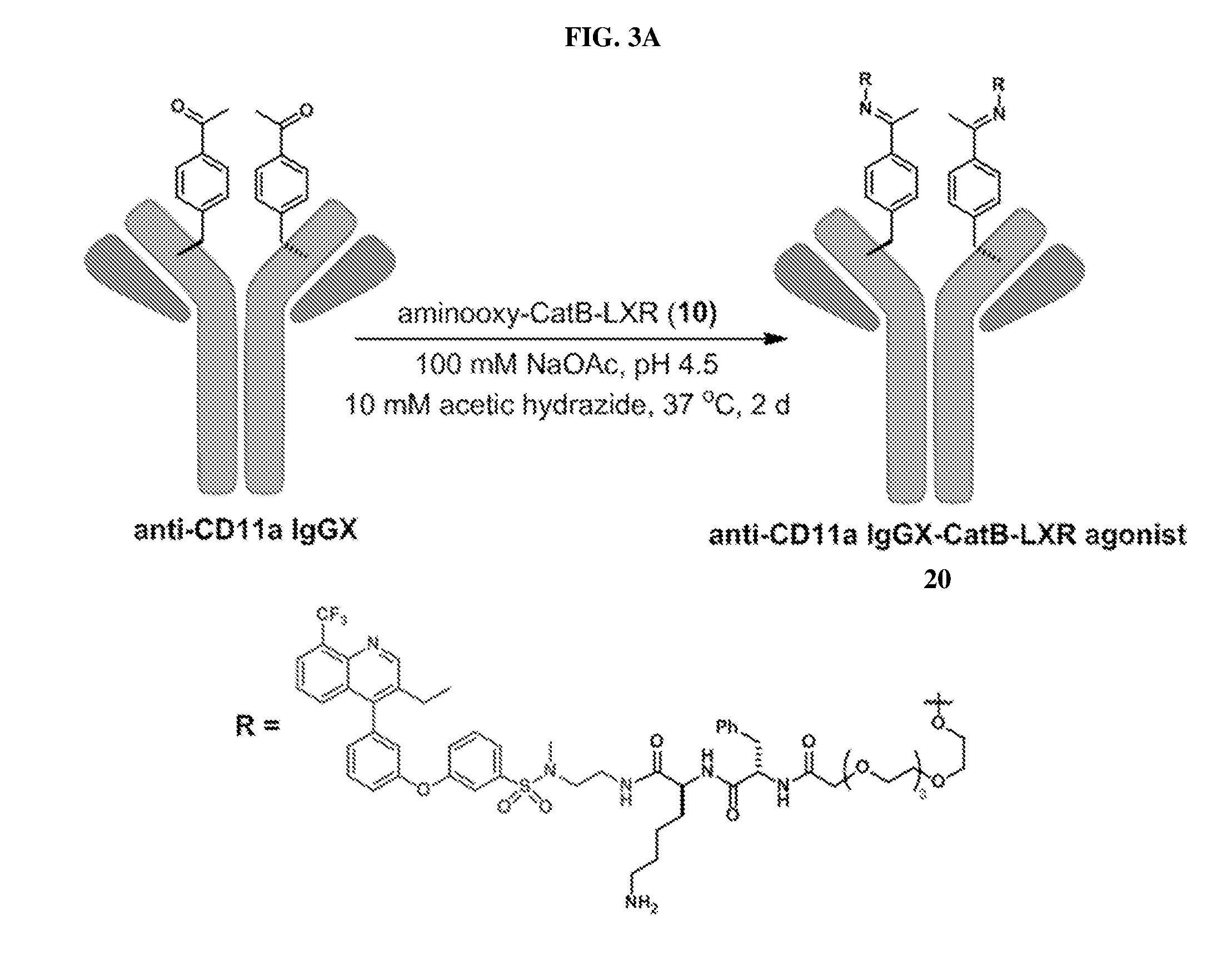Liver x receptor agonists and uses thereof
a technology agonist, which is applied in the field of liver x receptor agonists, can solve the problems of limited indications outside oncology and hindered therapeutic potential
- Summary
- Abstract
- Description
- Claims
- Application Information
AI Technical Summary
Benefits of technology
Problems solved by technology
Method used
Image
Examples
example 1
Design and Synthesis of the LXR Agonist
[0115]GW396523 and T09013178, shown in FIG. 1, are two widely used LXR agonists to study cardiovascular diseases. However, based on the reported structure-activity relationships (SAR), these two agonists fit tightly within the LXR receptor binding site and, as such, would be difficult to derivatize with a linker for antibody conjugation while retaining potency. A highly potent LXR agonist (compound 8, FIG. 2) was identified that tolerates modification at its sulfonamide group. To determine whether the core structures of these agonists can be used to generate highly potent, antibody-linked LXR agonists, compound 3 was synthesized from compound 8 with an aminoethyl sulfonamide substituent as shown in the schemes of FIG. 2 and FIG. 14. LXR binding with compound 3 was tested in comparison with compound 1 and compound 2 (LXR-α / LXR-β LanthaScreen, Life Technologies). Indeed, the modification of compound 8 is well-tolerated and compound 3 exhibits sim...
example 2
Design and Synthesis of Anti-CD11a IgGX-LXR Agonist ADC
[0118]Synthesis of the corresponding ADC was performed with the linker-derivatized LXR agonist from Example 1. To selectively deliver a LXR agonist to macrophages, CD11a was used as a target antigen. CD11a is the α-chain component of the lymphocyte function-associated antigen 1 (LFA-1). Although CD11a is expressed on most leukocytes, including lymphocytes and granulocytes, expression is abundant on monocytes and macrophages, and importantly, CD11a is not expressed on hepatocytes. Moreover, an increase in the expression of CD11a on monocytes is correlated with atherosclerotic coronary stenosis. CD11a receptors also internalize rapidly, and there are high affinity antibodies readily available (Kd˜2.2 nM) making it an attractive choice for this ADC.
[0119]In this study, unnatural amino acid (UAA) technology was utilized to incorporate a bio-orthogonal moiety (para-acetylphenylalanine, pAcF) site-specifically into anti-CD11a IgG for ...
example 3
Binding and Internalization of Anti-CD11a IgGX
[0124]The affinity, specificity and internalization of the anti-CD11a IgGX-CatB-LXR agonist antibody (molecule 20, FIG. 3A) was determined. Anti-CD11a IgGX and negative controls (anti-Her2 IgGX and anti-Her2 FabX) were site-specifically conjugated to aminooxy-Alexa Fluor 488 (AF488, Life Technologies) as described in Example 2. FIG. 15A shows an ESI-MS spectra of anti-CD11a IgGX-AF488. FIG. 15B shows an ESI-MS spectra of anti-Her2 IgGX-AF488. FIG. 15C shows an ESI-MS spectra of anti-Her2 FabX-AF488.
[0125]To assess the binding affinity of anti-CD11a IgGX and confirm it does not bind hepatocytes, human THP-1 monocyte / macrophage cells and human HepG2 hepatoma cells were incubated with anti-CD11a IgGX-AF488, anti-Her2 IgGX-AF488 and anti-Her2 FabX-AF488 and analyzed the results by flow cytometry. Because monocytes / macrophages have Fcγ receptors, the binding in the presence of an Fc blocking reagent was also examined (BD biosciences). As depi...
PUM
| Property | Measurement | Unit |
|---|---|---|
| Fraction | aaaaa | aaaaa |
| Fraction | aaaaa | aaaaa |
| Structure | aaaaa | aaaaa |
Abstract
Description
Claims
Application Information
 Login to View More
Login to View More - R&D
- Intellectual Property
- Life Sciences
- Materials
- Tech Scout
- Unparalleled Data Quality
- Higher Quality Content
- 60% Fewer Hallucinations
Browse by: Latest US Patents, China's latest patents, Technical Efficacy Thesaurus, Application Domain, Technology Topic, Popular Technical Reports.
© 2025 PatSnap. All rights reserved.Legal|Privacy policy|Modern Slavery Act Transparency Statement|Sitemap|About US| Contact US: help@patsnap.com



